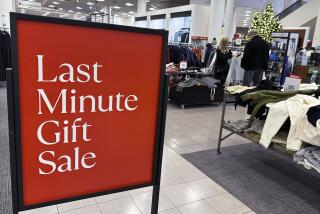Gift Returns Present Way to Better Business
Confronted by a day after Christmas that involves almost as many returns as purchases, many retailers loosen and simplify their rules on returns: “At holiday time, we tend to be more liberal,” says Holly Schmidt, manager of customer services for Marshall Field’s in Chicago.
This is less holiday spirit than good business sense. Gift returns require a visit, in many cases giving the retailer an introduction “to customers who’ve never been in our store,” says Charles Zahka, vice president of consumer services for the Broadway stores in Southern California.
Being liberal is not usually required by law. What laws exist, state or municipal, generally say that retailers can follow any policy they like as long as it’s “clearly and conspicuously” disclosed, in the words of the Massachusetts regulation. New York City’s ordinance adds that if nothing’s posted, the consumer with a receipt has a right to cash or credit within 20 days.
Refund or Credit
Most posted policies apply to what consumers buy for themselves. Gifts are so-called unreceipted returns, and if they get particularly liberal treatment, the practice is informal, unwritten and maybe variable. The posted refund and exchange policy at Boston’s Jordan Marsh, for example, requires that “merchandise must be returned within 10 days of sale, accompanied by a sales check and in its original condition.” Although the store claims to be liberal with gift returns, it won’t say how liberal: “If we get more specific,” a spokesman says, “that becomes policy.”
The big difference between a purchase and a gift is the sales slip, which proves, among other things, where the goods were bought. Now, given the spread of many brands, big stores will often exchange anything they stock: “If we carry it, we’ll take it,” Zahka says. “An Arrow shirt’s an Arrow shirt.” Small stores may ask for proof of source, unless what they carry is unique. “We can usually tell by the merchandise,” says Barbara Harris, co-owner of My New Friends, a children’s store in Santa Monica.
What they’ll give in exchange--refund or credit--is the knottier question, and is rarely specified in the posted policy. At Sears stores, for example, whether the customer gets a merchandise credit, cash or check is ultimately “at the discretion” of the store manager, a spokesman says.
Merchandise credits are a problem only when people can’t find anything else they like at the store--a particular problem at small stores, which offer limited selections. That’s also where the tradition of merchandise credits persists, because the owners “can’t or won’t absorb a small loss to gain good will,” says Tim Bissell, chief investigator for the Los Angeles Consumer Affairs Department, which gets many complaints on this score just after Christmas. My New Friends, co-owner Marcia Sautaers says, doesn’t give back cash “because we’ve spent it.”
Question Is How Much
More big stores now will offer money rather than carrying a credit on their books. People prefer it, they explain. (Actually, their true customer, who bought the gift, might not prefer it: If he’d wanted to give money, he would have.) Some won’t give cash on the spot but offer to mail a check later. This practice discourages shoplifters pretending to return what they just stole: They “tend to turn and just leave the store” when asked for name and address, Zahka says.
The final question is how much of a refund or credit they’ll give. Given the tradition of after-Christmas sales, the price on the day a gift is returned may be much lower than what was actually paid. The advent of before -Christmas promotions confuses the pricing even more.
Still, most stores offer the price current on the day of return--an obvious financial gain for the store--if there’s no sales slip, or, says a Sears spokesman, “other proof of price.” That could be a record or indication of the date of purchase--maybe just Christmas gift wrapping, Zahka says, or the fact it’s “brought in two days after Christmas.”
To cancel all doubt, Marshall Field’s salespeople put a sticker on the package with coded information as to item number, date and purchase price, “so we know exactly what was paid,” Schmidt says, “and that’s what the person gets back.” Some stores copy the technique, but poorly, making such stickers available only at special gift wrap desks. Some better it: Seattle-based Nordstrom stores require salespeople to cut off the price and write such coded information on every sales tag every time something is sold, gift or not, Christmas or not.
Long-Range View
It seems easy to do: It only takes a pencil. It even seems reasonable to demand. Where such dating isn’t automatic, consumers might ask salespeople to note the date on the tag and initial it.
Weighed against the immediate advantage of close-fisted return policies is the opportunity seized by stores which take a long-range view of every gift-receiver as a potential buyer, or alternatively, an unhappy visitor. Here the big retailer, with varied selection and multiple departments, has more at stake than the small one: “If you upset someone in housewares,” Zahka says, “they may stop buying nylons.”
There is even some short-term advantage to making sure that gift returns are no hassle. After-Christmas traffic is very high, given all the people with time off and Christmas money, and all the after-Christmas bargains. What’s more, almost three-quarters of people returning gifts, the Broadway found, will choose an exchange over a refund, often for an item of greater value than the gift. The result, Zahka says, is that in spite of the number of returns, the day after Christmas produces a net volume as high as the day after Thanksgiving, the industry’s traditional high water mark for sales.
More to Read
Inside the business of entertainment
The Wide Shot brings you news, analysis and insights on everything from streaming wars to production — and what it all means for the future.
You may occasionally receive promotional content from the Los Angeles Times.










